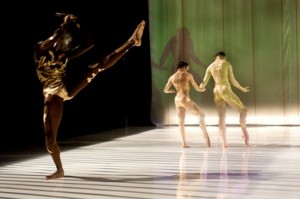JACOB’S PILLOW DANCE FESTIVAL
zoe | juniper
Doris Duke Theatre
July 20, 2011
Review by Anna Rogovoy
(BECKET, Mass.) – The Doris Duke Theatre at Jacob’s Pillow has been transformed, by way of white floor paneling, towering screens, powerful sounds, and eerie characters, into another world. Audience members filing in to take their seats are met by rippling water projected onto a panel which significantly reduces the depth of the normally large stage, a projection which foreshadows the rippling beauty and strangeness of the events to come. The world we have entered belongs to the creative team of Zoe Scofield and Juniper Shuey, doing artistic business as zoe | juniper, and odd beauty characterizes the entirety of the hour-long world premiere of A Crack in Everything.
Zoe Scofield’s choreography bears traces of diverse influence. Her ballet training is reflected in her attention to line, while molasses-slow gestures recall Japanese butoh. Wacky isolations of the head, limbs, and torso give way to undulations that travel throughout the body. Fantastically deep lunges reminiscent of Andrea Miller (whose work can be seen next Saturday on students of the School at Jacob’s Pillow) and other Batsheva/Ohad Naharin/Gaga-influenced choreographers juxtapose elegant, arching backs. What is truly Scofield’s are the unexpected ways and orders in which she links each gesture or phrase to the next. And, of course, there is the added effect of Shuey’s contributions.
A Crack in Everything is above all visually arresting. In addition to Shuey’s innovative use of filmed dance, wherein by changes of lighting the dancers onstage are at times mimicked, contrasted, or replaced by virtual versions of themselves, decadent layered costumes by Erik Andor render the four women and one man of the company luxuriously gilded. Scofield uses all of these elements to her advantage, allowing the focus to shift from tableau to movement to tableau again. In one particularly striking section, one of the women of the company traces her own outline in red ink against the sheer panel at the front of the stage. The lighting illuminates several events occurring behind the panel, including a vigorous duet for Anna Schon and Raja Kelly, another woman with her back to the audience who periodically bursts into fits of spasmodic gesture, and a black-hooded figure slowly making its way forward. It’s a lot to take in, but there’s just enough balance between consistency and variation in the movement to be gripping without being overwhelming.
Duets between Schon and Kelly happen several times throughout the course of the work, and each time a fascinating paradox occurs. Schon, by far the most petite member of the company, consistently overpowers the towering Kelly. Her compact, supple body oozes a kind of sensuality and magnetism that extends far beyond her edges, while he doesn’t quite seem to use his entire physicality. A good performer, one can only imagine the kind of effect Kelly would have if he were to project his energy in the same way that Schon does. Particularly remarkable is the way in which, even as her lower body contorts in impossibly deep pliés, Schon’s head remains isolated, adding to the otherworldly, sub-human feel of the movement.
There’s a mesmerizing, eerie quality to each dancer’s performance, to the score (by Greg Haines with samples from Johann Johannson, Schubert, and Morgan Henderson), and to the often dim yet evocative lighting. It is so hypnotic that when, following a rousing sequence in which four dancers perform in unison while Scofield moves upstage of them, the lights shift, leaving Scofield illuminated in a throbbing rectangle for mere moments before she collapses and they go dark altogether, it’s hard to say whether an hour or much less time has passed. It is a bizarre and wonderful rabbit hole we have fallen down, and upon emerging there is much to ponder.
Anna Rogovoy is chief dance critic for The Rogovoy Report. She studies dance, literature and writing at Bennington College.

